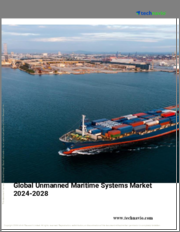
|
시장보고서
상품코드
1665413
무인 해상 차량 시장 기회, 성장 촉진요인, 산업 동향 분석, 예측(2025-2034년)Unmanned Marine Vehicles Market Opportunity, Growth Drivers, Industry Trend Analysis, and Forecast 2025 - 2034 |
||||||
세계의 무인 해상 차량 시장은 2024년에 48억 달러로 평가되며, 2025-2034년에 CAGR 6.8%로 성장할 것으로 예측됩니다. 해상 보안 및 모니터링에 대한 수요 증가가 이러한 성장의 주요 원동력이 되고 있습니다. 세계 각국 정부는 국가 안보 강화, 해안 지역 감시, 항로 안전 확보를 위해 무인 시스템을 채택하고 있습니다. 이러한 차량은 정보 수집, 지뢰 감지, 해저 영역 인식 강화 등의 분야에서 중요한 역할을 하고 있습니다. 최첨단 자율성과 센서 기술의 통합으로 UMV는 해양 방어에 필수적인 존재가 되고 있습니다. 또한 항법 기술에 대한 투자는 자율 해양 시스템의 진보를 가속화하여 의사결정 개선, 항로 최적화, 장애물 감지 능력을 향상시키고 있습니다. 이러한 기술 혁신은 인간의 개입에 대한 의존도를 낮추고 열악한 해양 조건에서 효율적이고 장기적인 임무를 지원할 수 있습니다.

UMV는 원격 조종 차량과 자율주행 차량을 포함한 제어 시스템을 기준으로 분류되며, 2024년 시장 점유율은 자율주행형이 69.3%로 압도적인 비중을 차지했습니다. 이 차량들은 인간의 개입을 최소화하고 위험도가 높은 작업을 수행함으로써 해상 작업에 혁명을 일으키고 있습니다. 첨단 AI와 머신러닝 알고리즘을 탑재한 자율형 UMV는 복잡한 환경을 탐색하고 다양한 상황에 적응할 수 있으며, 운영 효율성과 임무의 효율성을 높이고 있습니다. 거친 바다나 위험 지역과 같은 열악한 환경에서도 활동할 수 있으며, 승무원과 관련된 위험을 줄이면서 장시간 임무에 대응할 수 있는 비용 효율적인 솔루션입니다.
| 시장 범위 | |
|---|---|
| 시작연도 | 2024년 |
| 예측연도 | 2025-2034년 |
| 시작 금액 | 48억 달러 |
| 예상 금액 | 93억 달러 |
| CAGR | 6.8% |
UMV 수요는 국방, 연구, 상업 등 다양한 용도로 증가하고 있습니다. 상업 분야가 가장 빠르게 성장하고 있으며, 예측 기간 중 CAGR은 7.9%로 예측됩니다. 이러한 성장의 배경에는 해양 조사, 석유 및 가스 탐사, 해저 인프라 검사 등 수요가 증가하고 있으며, UMV는 가혹한 조건에서 자율적으로 작업할 수 있으며, 인간의 위험을 최소화할 수 있고, 승무원이 필요 없고 지속적인 데이터 수집을 통해 작업 효율을 높일 수 있으며, 장시간 임무에 필수적입니다. 지속적인 데이터 수집을 통해 작업 효율성을 높일 수 있습니다. 또한 환경 모니터링과 지속가능성에 중점을 두어 해양 조사 및 오염 추적에 대한 채택이 증가하고 있습니다. 복잡한 해저 지형을 항해하고 정확한 데이터를 수집할 수 있는 능력은 에너지, 농업, 해운 등의 산업에 필수적인 요소로 자리 잡고 있습니다.
북미 시장은 자율운항 해양 기술에 대한 막대한 투자로 2034년까지 30억 달러를 넘어설 것으로 예상됩니다. 이 지역은 지속가능한 관행과 규제 프레임워크를 통해 군 및 민간 해양 업무 모두에서 성장을 가속하고 있으며, UMV는 해저 탐사, 해양 물류, 해양 데이터 수집 분야에서 점점 더 많이 활용되고 있으며, 현대 해양 역량을 향상시키는 데 있으며, UMV의 중요성이 입증되고 있습니다. 그 중요성이 입증되고 있습니다.
목차
제1장 조사 방법과 조사 범위
- 시장 범위와 정의
- 기본 추정과 계산
- 예측 계산
- 데이터 소스
- 1차 데이터
- 2차 데이터
- 유료 정보원
- 공적 정보원
제2장 개요
제3장 업계 인사이트
- 에코시스템 분석
- 밸류체인에 영향을 미치는 요인
- 이익률 분석
- 파괴
- 향후 전망
- 제조업체
- 유통업체
- 공급업체 상황
- 이익률 분석
- 주요 뉴스와 구상
- 규제 상황
- 영향요인
- 촉진요인
- 해상 감시 및 방위 애플리케이션의 수요 증가
- 자율 항행 기술의 진보에 대한 투자의 증가
- 세계의 석유 및 가스 탐사 수요의 확대
- 해양 조사에서 무인 해상 차량의 채택 확대
- 환경 모니터링 및 재해 대응 업무의 요구 증가
- 업계의 잠재적 리스크 & 과제
- 첨단 시스템의 높은 초기 개발·도입 비용
- 국제 수역에서의 자율 운영에 관한 규제 프레임워크가 한정적
- 촉진요인
- 성장 가능성 분석
- Porter의 산업 분석
- PESTEL 분석
제4장 경쟁 구도
- 서론
- 기업 점유율 분석
- 경쟁 포지셔닝 매트릭스
- 전략 전망 매트릭스
제5장 시장 추산·예측 : 유형별, 2021-2034년
- 주요 동향
- 수상 차량
- 수중 차량
제6장 시장 추산·예측 : 컨트롤별, 2021-2034년
- 주요 동향
- 원격 조작 차량
- 자율주행 차량
제7장 시장 추산·예측 : 속도별, 2021-2034년
- 주요 동향
- 10 노트 이하
- 10-30 노트
- 30 노트 이상
제8장 시장 추산·예측 : 내구성별, 2021-2034년
- 주요 동향
- 100시간 미만
- 100-500시간
- 500-1,000시간
- 1,000시간 이상
제9장 시장 추산·예측 : 솔루션별, 2021-2034년
- 주요 동향
- 추진 시스템
- 통신 시스템
- 페이로드
- 섀시 재료
- 기타 솔루션
제10장 시장 추산·예측 : 최종 용도별, 2021-2034년
- 주요 동향
- 방위
- 조사
- 상업
- 기타
제11장 시장 추산·예측 : 지역별, 2021-2034년
- 주요 동향
- 북미
- 미국
- 캐나다
- 유럽
- 영국
- 독일
- 프랑스
- 이탈리아
- 스페인
- 러시아
- 아시아태평양
- 중국
- 인도
- 일본
- 한국
- 호주
- 라틴아메리카
- 브라질
- 멕시코
- 중동 및 아프리카
- 남아프리카공화국
- 사우디아라비아
- 아랍에미리트
제12장 기업 개요
- ASV Global
- Atlas Elektronik
- BAE Systems
- Bharat Dynamics Limited(BDL)
- ECA Group
- General Dynamics
- L3Harris Technologies
- Liquid Robotics
- Northrop Grumman
- Ocean Aero Inc.
- Pelorus Naval Systems
- Rafael Advanced Defense Systems
- Saab AB
- Sea Robotics Inc.
- Teledyne Technologies Inc.
- Textron Inc.
- Thales Group
- Unmanned Systems Technology
The Global Unmanned Marine Vehicles Market, valued at USD 4.8 billion in 2024, is anticipated to grow at a CAGR of 6.8% from 2025 to 2034. The increasing need for maritime security and surveillance is a key driver for this growth. Governments worldwide are adopting unmanned systems to strengthen national security, monitor coastal areas, and safeguard shipping lanes. These vehicles play a crucial role in applications such as intelligence gathering, mine detection, and enhancing undersea domain awareness. The integration of cutting-edge autonomy and sensor technologies has established UMVs as indispensable in maritime defense. Additionally, investments in navigation technology are accelerating advancements in autonomous marine systems, enabling improved decision-making, enhanced route optimization, and better obstacle-detection capabilities. These innovations reduce reliance on human intervention, supporting efficient and extended missions in challenging marine conditions.

UMVs are classified based on control systems, including remotely operated vehicles and autonomous vehicles. The autonomous segment dominated the market in 2024, capturing 69.3% of the market share. These vehicles are revolutionizing maritime operations by performing high-risk tasks with minimal human involvement. Equipped with advanced AI and machine learning algorithms, autonomous UMVs can navigate complex environments and adapt to varying conditions, enhancing their operational efficiency and mission effectiveness. Their ability to operate in harsh environments, such as rough seas or hazardous zones, makes them cost-effective solutions for extended missions while reducing crew-related risks.
| Market Scope | |
|---|---|
| Start Year | 2024 |
| Forecast Year | 2025-2034 |
| Start Value | $4.8 Billion |
| Forecast Value | $9.3 Billion |
| CAGR | 6.8% |
The demand for UMVs is increasing across various applications, including defense, research, and commercial sectors. The commercial segment is witnessing the fastest growth, with a projected CAGR of 7.9% during the forecast period. This growth is driven by rising needs in marine surveying, oil and gas exploration, and subsea infrastructure inspections. UMVs enable autonomous operations in extreme conditions, minimizing human exposure to danger. These vehicles are essential for long-duration missions, offering operational efficiency through continuous data collection without requiring a physical crew. Additionally, the focus on environmental monitoring and sustainability has boosted their adoption for oceanographic studies and pollution tracking. Their capability to navigate complex underwater terrains and collect accurate data makes them indispensable for industries such as energy, agriculture, and shipping.
The North American market is poised to exceed USD 3 billion by 2034, driven by substantial investments in autonomous marine technologies. The region's commitment to sustainable practices and regulatory frameworks fosters growth in both military and civilian maritime operations. UMVs are increasingly utilized in subsea exploration, offshore logistics, and ocean data collection, ensuring their prominence in advancing modern maritime capabilities.
Table of Contents
Chapter 1 Methodology & Scope
- 1.1 Market scope & definitions
- 1.2 Base estimates & calculations
- 1.3 Forecast calculations
- 1.4 Data sources
- 1.4.1 Primary
- 1.4.2 Secondary
- 1.4.2.1 Paid sources
- 1.4.2.2 Public sources
Chapter 2 Executive Summary
- 2.1 Industry synopsis, 2021-2034
Chapter 3 Industry Insights
- 3.1 Industry ecosystem analysis
- 3.1.1 Factor affecting the value chain
- 3.1.2 Profit margin analysis
- 3.1.3 Disruptions
- 3.1.4 Future outlook
- 3.1.5 Manufacturers
- 3.1.6 Distributors
- 3.2 Supplier landscape
- 3.3 Profit margin analysis
- 3.4 Key news & initiatives
- 3.5 Regulatory landscape
- 3.6 Impact forces
- 3.6.1 Growth drivers
- 3.6.1.1 Rising demand for maritime surveillance and defense applications
- 3.6.1.2 Increasing investments in autonomous navigation technology advancements
- 3.6.1.3 Expanding offshore oil and gas exploration requirements globally
- 3.6.1.4 Growing adoption of unmanned marine vehicles for ocean research
- 3.6.1.5 Rising need for environmental monitoring and disaster response operations
- 3.6.2 Industry pitfalls & challenges
- 3.6.2.1 High initial development and deployment costs for advanced systems
- 3.6.2.2 Limited regulatory framework for autonomous operations in international waters
- 3.6.1 Growth drivers
- 3.7 Growth potential analysis
- 3.8 Porter’s analysis
- 3.9 PESTEL analysis
Chapter 4 Competitive Landscape, 2024
- 4.1 Introduction
- 4.2 Company market share analysis
- 4.3 Competitive positioning matrix
- 4.4 Strategic outlook matrix
Chapter 5 Market Estimates & Forecast, By Type, 2021-2034 (USD Million)
- 5.1 Key trends
- 5.2 Surface vehicle
- 5.3 Underwater vehicle
Chapter 6 Market Estimates & Forecast, By Control, 2021-2034 (USD Million)
- 6.1 Key trends
- 6.2 Remotely operated vehicles
- 6.3 Autonomous vehicles
Chapter 7 Market Estimates & Forecast, By Speed, 2021-2034 (USD Million)
- 7.1 Key trends
- 7.2 Up to 10 knots
- 7.3 10−30 knots
- 7.4 More than 30 knots
Chapter 8 Market Estimates & Forecast, By Endurance, 2021-2034 (USD Million)
- 8.1 Key trends
- 8.2 <100 hours
- 8.3 100−500 hours
- 8.4 500−1,000 hours
- 8.5 >1,000 hours
Chapter 9 Market Estimates & Forecast, By Solution, 2021-2034 (USD Million)
- 9.1 Key trends
- 9.2 Propulsion system
- 9.3 Communication system
- 9.4 Payload
- 9.5 Chassis material
- 9.6 Other solutions
Chapter 10 Market Estimates & Forecast, By End Use Application, 2021-2034 (USD Million)
- 10.1 Key trends
- 10.2 Defense
- 10.3 Research
- 10.4 Commercial
- 10.5 Others
Chapter 11 Market Estimates & Forecast, By Region, 2021-2034 (USD Million)
- 11.1 Key trends
- 11.2 North America
- 11.2.1 U.S.
- 11.2.2 Canada
- 11.3 Europe
- 11.3.1 UK
- 11.3.2 Germany
- 11.3.3 France
- 11.3.4 Italy
- 11.3.5 Spain
- 11.3.6 Russia
- 11.4 Asia Pacific
- 11.4.1 China
- 11.4.2 India
- 11.4.3 Japan
- 11.4.4 South Korea
- 11.4.5 Australia
- 11.5 Latin America
- 11.5.1 Brazil
- 11.5.2 Mexico
- 11.6 MEA
- 11.6.1 South Africa
- 11.6.2 Saudi Arabia
- 11.6.3 UAE
Chapter 12 Company Profiles
- 12.1 ASV Global
- 12.2 Atlas Elektronik
- 12.3 BAE Systems
- 12.4 Bharat Dynamics Limited (BDL)
- 12.5 ECA Group
- 12.6 General Dynamics
- 12.7 L3Harris Technologies
- 12.8 Liquid Robotics
- 12.9 Northrop Grumman
- 12.10 Ocean Aero Inc.
- 12.11 Pelorus Naval Systems
- 12.12 Rafael Advanced Defense Systems
- 12.13 Saab AB
- 12.14 Sea Robotics Inc.
- 12.15 Teledyne Technologies Inc.
- 12.16 Textron Inc.
- 12.17 Thales Group
- 12.18 Unmanned Systems Technology


















